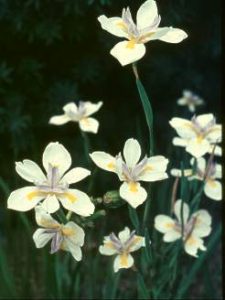This notable native iris is ordinarily filled in gardens and utilized in enormous scenes all through the country.

Dietes grandiflora
Portrayal
Dietes grandiflora is an enduring, evergreen plant which grows up to 1.5 m, shaping enormous bunches. The plant develops from underground rhizomes.
The long, unbending, blade formed leaves, held in a fan shape, are dull green and may arrive at up to 1 m long and 15-20 mm wide.
The appealing blossoms, hung on erect thin stems around 1 m long, are enormous (around 100 mm across) and are white with yellow nectar guides on the external tepals and violet focal sections.
Blossom and seed container
The blossoms are borne in masses at specific periods — frequently after downpour in summer. The singular blossoms don’t endure in excess of several days (so are of no utilization in a jar) in any case, the plant bears such countless blossoms during the pinnacle time frame that the plant looks generally striking.
This plant is incidentally called the “Pixie Iris” in light of the fact that the delicate white petals seem to be pixie wings, yet in addition tend to vanish bafflingly short-term!
The huge wild iris natural product is an enormous case up to 45 mm which is held erect and parts open to deliver sparkly, dim earthy colored seeds.
Preservation Status
Least Concern (LC), Dietes grandiflora isn’t undermined.
Circulation and territory
It develops normally along the southern and eastern waterfront region of the Eastern Cape and southern Kwazulu-Natal where it very well might be tracked down in full sun or halfway shade at timberland edges, or in the sanctuary of taller bushes on uncovered slants confronting the ocean.
Deduction of name and authentic viewpoints
The name Dietes signifies ‘having two family members’ and alludes to the connection between this class and Moraea and Iris. Grandiflora signifies ‘enormous bloom’.
There are 6species of Dietes — five of which happen in South Africa — and one on an island in the Tasman Ocean (between New Zealand and Australia). Dietes were once called Moraea (a firmly related bunch), however were isolated in light of the fact that Dietes have a rhizome, though Moraea have a genuine corm.
Bed of Dietes grandiflora
Biology
The blossoms draw in bunches of honey bees and different pollinators.
Utilizes
It has turned into a well known finishing plant because of its unwavering quality and toughness and is much of the time found in stopping regions at malls, schools and so on. It very well may be really utilized in mass plantings, but at the same time is viable in blended plantings or utilized as a highlight plant close by a lake or a few stages.
Developing Dietes grandiflora
This is a well known, simple to-develop garden plant which will develop under most circumstances. The plants are both ice and dry season tough and will fill in one or the other sun or shade. Be that as it may, for best outcomes and most blossoms, plant Dietes grandiflora in full sun or light shade in all around treated the soil, very much depleted soil and water well in summer.
The huge wild iris is not difficult to engender from seed planted in spring or by partitioning enormous bunches which spread through rhizomes. They duplicate quickly and are before long fit to be parted once more.